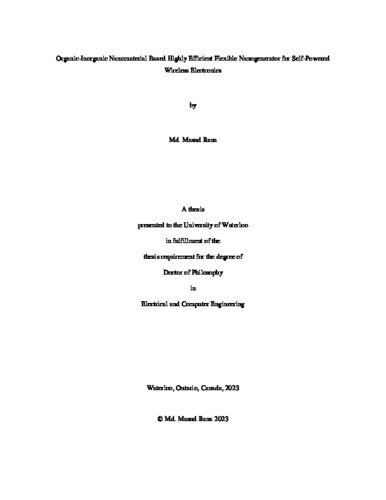UWSpace will be migrating to a new version of its software from July 29th to August 1st. UWSpace will be offline for all UW community members during this time.
Organic-Inorganic Nanomaterial Based Highly Efficient Flexible Nanogenerator for Self-Powered Wireless Electronics
| dc.contributor.author | Rana, Md. Masud | |
| dc.date.accessioned | 2023-05-01 17:39:52 (GMT) | |
| dc.date.available | 2023-05-01 17:39:52 (GMT) | |
| dc.date.issued | 2023-05-01 | |
| dc.date.submitted | 2023-04-24 | |
| dc.identifier.uri | http://hdl.handle.net/10012/19371 | |
| dc.description.abstract | As the world progresses towards artificial intelligence and the Internet of Things (IoT), self‐powered sensor systems are increasingly vital for sensing and detection. Nanogenerators, a new technology in energy research, enable the harvesting of normally wasted energy from the environment. This technology scavenges a wide range of ambient energies, meeting the ever-expanding energy demands as conventional fossil fuel sources are depleted. This research involves designing and fabricating high-performance flexible piezoelectric nanogenerators (PENGs) and triboelectric nanogenerators (TENGs), using novel organic-inorganic hybrid nanomaterials for wireless electronics. Structural health monitoring (SHM) is crucial in the aerospace industry to enhance aircraft safety and consistency through reliable sensor networks. PENGs are promising for powering wireless sensor networks in aerospace SHM applications due to their sustainability, durability, flexibility, high performance, and superior reliability. This research demonstrated a self-powered wireless sensing system based on a porous PVDF (polyvinylidene fluoride)-based PENG, which is ideal for developing auto-operated sensor networks. The porous PVDF film-based PENG, enhanced output current by ~ 11 times and output voltage by ~ 8 times, respectively, compared to a pure PVDF-based PENG. The PENG device generated sufficient electrical energy to power a customized wireless sensing and communication unit and transfer sensor data every ~ 4 minutes. This PENG could harness energy from automobile vibration, reflecting the potential for real-life SHM systems. Subsequently, a novel, self-assembled, highly porous perovskite (FAPbBr2I)/polymer (PVDF) composite film was designed and developed to fabricate high-performance piezoelectric nanogenerators (PENGs). The porous structure enlarged the bulk strain of the piezoelectric composite film, resulting in a 5-fold enhancement of the strain-induced piezo potential and a 15-fold amplification of the output current. This highly-efficient PENG achieved a peak output power density of 10 µW/cm2 and enabled to run a self-powered integrated wireless electronic node (SIWEN). The PENG was applied to real-life scenarios including wireless data communication, efficient energy harvesting from automobile vibrations as well as biomechanical motion. This low-temperature, full-solution synthesis approach could lead to a paradigm shift in sustainable power sources, expanding the realms of flexible PENGs. One of the remaining concerns is the highly soluble lead component, which is one of the constituents of the PENGs that poses potential adversary impacts on human health and the environment. To address this concern, lead-free organic-inorganic hybrid perovskite (OIHP) based flexible piezoelectric nanogenerators (PENGs) have been developed. The excellent piezoelectric properties of the FASnBr3 NPs was demonstrated with a high piezoelectric charge coefficient (d33) of ~ 50 pm/V through piezoelectric force microscopy (PFM) measurements. The device’s outstanding flexibility and uniform distribution properties resulted in a maximum piezoelectric peak-to-peak output voltage of 94.5 V, peak-to-peak current of 19.1 μA, and output power density of 18.95 μW/cm2 with a small force of 4.2 N, outperforming many state-of-the-art halide perovskite-based PENGs. For the first time, a self-powered RF wireless communication between smartphones and a nanogenerator solely based on a lead-free PENG was demonstrated and serves as a stepping-stone towards achieving self-powered Internet of Things (IoT) devices using environment-friendly perovskite piezoelectric materials. Likewise, triboelectric nanogenerators (TENGs) are also promising energy-harvesting devices for powering the next generation of wireless electronics. TENGs’ performance relies on the triboelectric effect between the tribonegative and tribopositive layers. In this study, a natural wood-derived lignocellulosic nanofibrils (LCNF) tribolayer was reported to have high tribonegativity (higher than polytetrafluoroethylene (PTFE)) due to the presence of natural lignin on its surface and its nanofibril morphology. LCNF nanopaper-based TENGs produced significantly higher voltage (160%) and current (120%) output than TENGs with PTFE as the tribonegative material. Assembling LCNF nanopaper into a cascade TENG generated sufficient output to power a wireless communication node to send a radio-frequency signal to a smartphone every 3 mins. This study demonstrates the potential of using LCNF as a more environmentally friendly alternative to conventional tribonegative materials based on fluorine-containing petroleum-based polymers. Overall, this thesis explores the design and development of highly efficient and flexible nanogenerators for self-powered wireless electronics. By combining highly electroactive nanomaterials with flexible polymer matrix structures, NGs with high electric output performance and flexibility were successfully obtained. The synthesizing process for the electroactive nanomaterials was carefully designed and adopted to sustain the inherent advantages of flexible electronics. The various type of high performance flexible NGs developed in this research work, including ZnO/PVDF porous PENGs, FAPbBr2I/PVDF based PENGs, FASnBr3/PDMS based PENGs, and LCNF nanopaper-based TENGs, provide promising solutions for energy harvesting and self-powered sensing. | en |
| dc.language.iso | en | en |
| dc.publisher | University of Waterloo | en |
| dc.title | Organic-Inorganic Nanomaterial Based Highly Efficient Flexible Nanogenerator for Self-Powered Wireless Electronics | en |
| dc.type | Doctoral Thesis | en |
| dc.pending | false | |
| uws-etd.degree.department | Electrical and Computer Engineering | en |
| uws-etd.degree.discipline | Electrical and Computer Engineering (Nanotechnology) | en |
| uws-etd.degree.grantor | University of Waterloo | en |
| uws-etd.degree | Doctor of Philosophy | en |
| uws-etd.embargo.terms | 0 | en |
| uws.contributor.advisor | Ban, Dayan | |
| uws.contributor.affiliation1 | Faculty of Engineering | en |
| uws.published.city | Waterloo | en |
| uws.published.country | Canada | en |
| uws.published.province | Ontario | en |
| uws.typeOfResource | Text | en |
| uws.peerReviewStatus | Unreviewed | en |
| uws.scholarLevel | Graduate | en |

